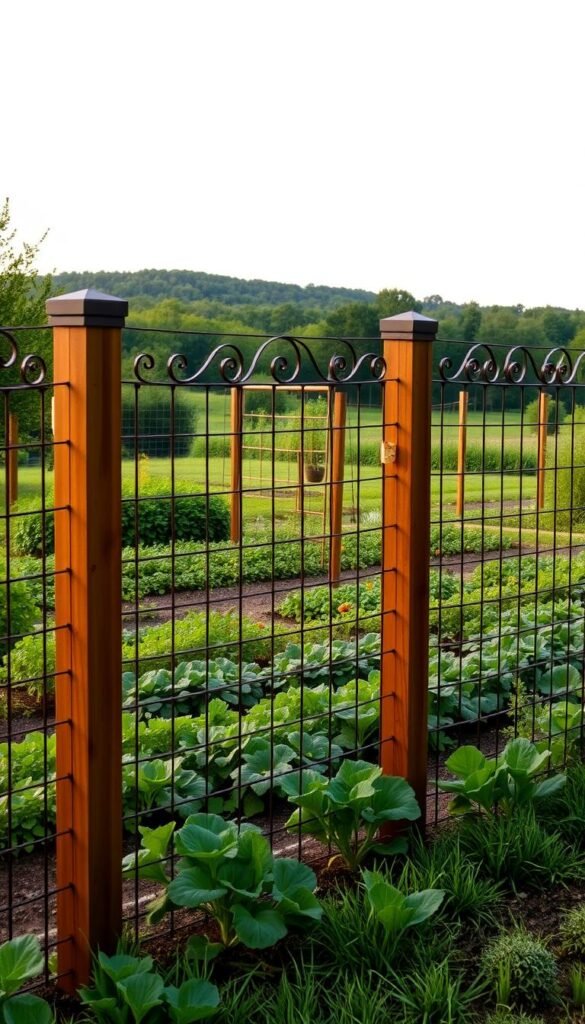Imagine growing fresh produce without worrying about hungry wildlife. Creating a beautiful, productive space requires smart design that balances safety and style. Take inspiration from Karen Chapman’s 1,800-square-foot growing area in rural Washington—larger than her home—where clever fencing keeps deer, rabbits, and burrowing pests at bay.
Traditional barriers often fail because they focus only on height. A single tall fence might stop deer but could overwhelm your yard’s aesthetics. Instead, innovative dual-layer systems offer better results. The Chapmans’ “boing-boing fence” uses two 5-foot barriers spaced five feet apart. Deer won’t risk jumping into tight spaces, while the design maintains harmony with their property.
You don’t need industrial-looking structures to protect your plants. Whether you’re guarding against curious raccoons or determined voles, solutions exist that complement your landscape. For example, vegetable garden fence ideas range from decorative metal mesh to temporary netting for raised beds.
This guide reveals how professionals tackle pest challenges without sacrificing visual appeal. Discover why proportion matters as much as protection, and learn how to turn your growing area into a charming focal point that enhances your outdoor space.
Embracing Your Pest-Free Garden Vision
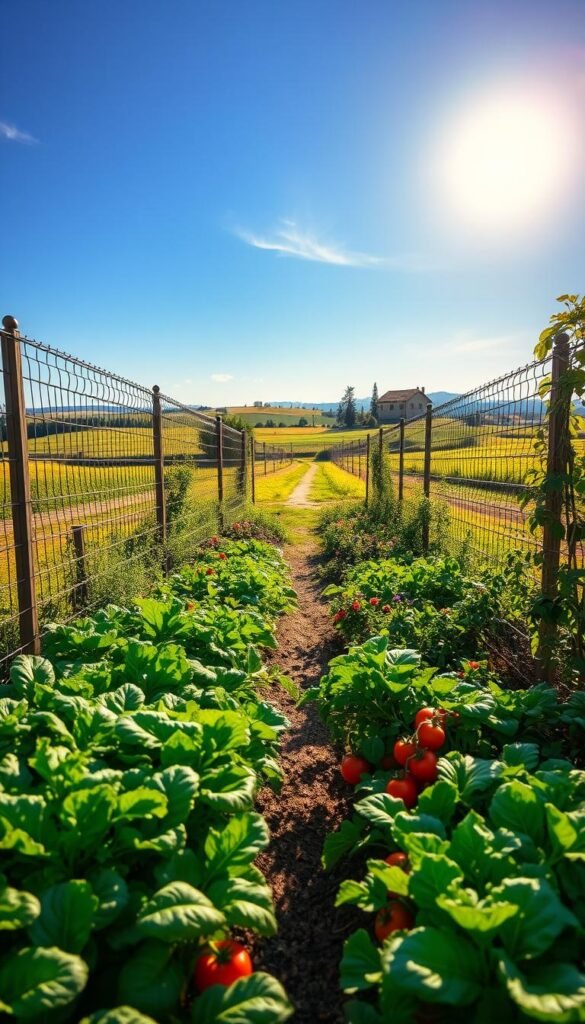
Your dream of fresh tomatoes and crisp greens doesn’t have to become a buffet for local wildlife. Smart barriers blend protection with beauty, letting your plants thrive while keeping unwanted visitors at a distance.
Why Protection Matters More Than You Think
Rabbits alone can munch through $600 worth of veggies in months. But a well-designed barrier costing under $350 safeguards 300 pounds of food yearly. It’s not just about keeping animals out—it’s about giving plants room to grow without stress.
Look for chew marks near bean plants or tiny tracks in soft soil. These clues reveal which creatures visit your area. Deer leave jagged bites on leaves, while mice nibble stems near the ground.
Stories From Thriving Growing Spaces
Ohio gardener Mia Rodriguez stopped rabbit raids using decorative metal grids that doubled as pea trellises. “The structure became part of my garden’s charm,” she says. Her kale now grows undisturbed beside flowering nasturtiums.
In Vermont, a couple combined chicken wire with willow branches to deter woodchucks. Their solution cost $80 and blended seamlessly into the landscape. By understanding local animal habits, they created defenses that worked with nature—not against it.
Planning and Designing Your Garden Layout
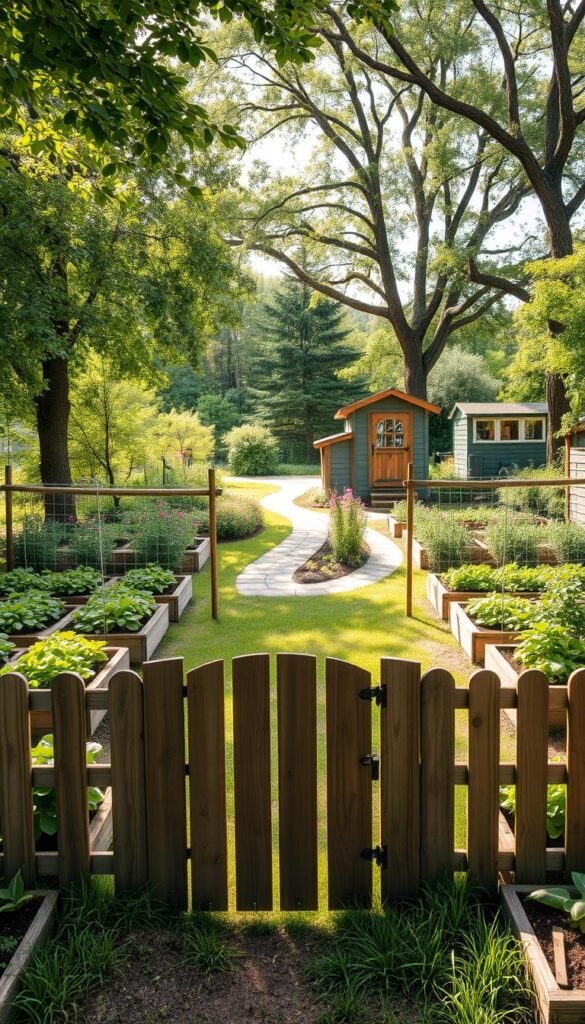
Designing your perfect growing space starts with smart layout choices. Whether you’re working with a small backyard or sprawling acreage, thoughtful organization boosts productivity while making maintenance easier. Let’s explore how to create a functional setup that grows with your needs.
Assessing Your Space and Garden Location
Begin by observing sunlight patterns and drainage in your chosen area. Most crops need 6-8 hours of direct sun daily. Walk your property at different times to identify the sunniest spots. Check for low-lying areas where water pools—these make poor locations for raised beds unless you add drainage solutions.
Consider proximity to water sources and storage. Karen Chapman’s successful design places her 3-foot-wide planting zones within 15 feet of rain barrels. This strategic location reduces hose dragging and encourages consistent watering.
Mapping Out Raised Beds and Pathways
Opt for 3-foot-wide beds—this width lets you reach the center from either side without stepping on soil. Narrower 18-inch versions work well for herbs or border plantings. Between beds, maintain 2-foot paths for kneeling access or 4-foot lanes for wheelbarrows.
Arrange beds in geometric patterns or curved lines to match your landscape. Chapman’s intersecting pathways create visual interest while providing access to every planting zone. Leave room for future expansions like compost bins or fruit bushes along fence lines.
Fenced Vegetable Garden: Keep Out Pests with Secure, Stylish Solutions
Protecting your harvest starts with smart barrier choices that balance practicality with visual harmony. While a single tall structure might seem logical, creative combinations often deliver better results. Let’s explore how to match your defenses to local wildlife behavior.
Choosing the Right Fence Height and Style
Deer can clear 8-foot barriers, but you don’t need towering walls. The Chapmans’ dual 5-foot fences spaced five feet apart create an optical illusion. “Deer won’t risk landing in tight spaces,” explains wildlife expert Dr. Ellen Parker. This approach maintains open sightlines while stopping 98% of jumps.
For entry points, cedar pergolas add vertical interest. Their 8-foot height deters deer without blocking sunlight. Pair them with hog-wire panels featuring smaller holes at the base—these block rabbits while supporting climbing beans or kiwi vines.
Incorporating Dual Fencing and Underground Barriers
Two shorter barriers often outperform one tall one. The air gap between fencing layers confuses animals’ depth perception. This psychological deterrent works year-round without requiring electricity or chemicals.
Don’t forget underground threats. Bury hardware cloth 3 feet deep around your perimeter. This stops moles from tunneling into carrot beds. One Oregon gardener reported, “My root crops survived untouched after installing this hidden shield.”
By layering above-ground and subterranean solutions, you create a fortress that looks like part of the landscape. Your plants thrive, and local wildlife simply moves along to easier meals.
Selecting Materials and Construction Techniques
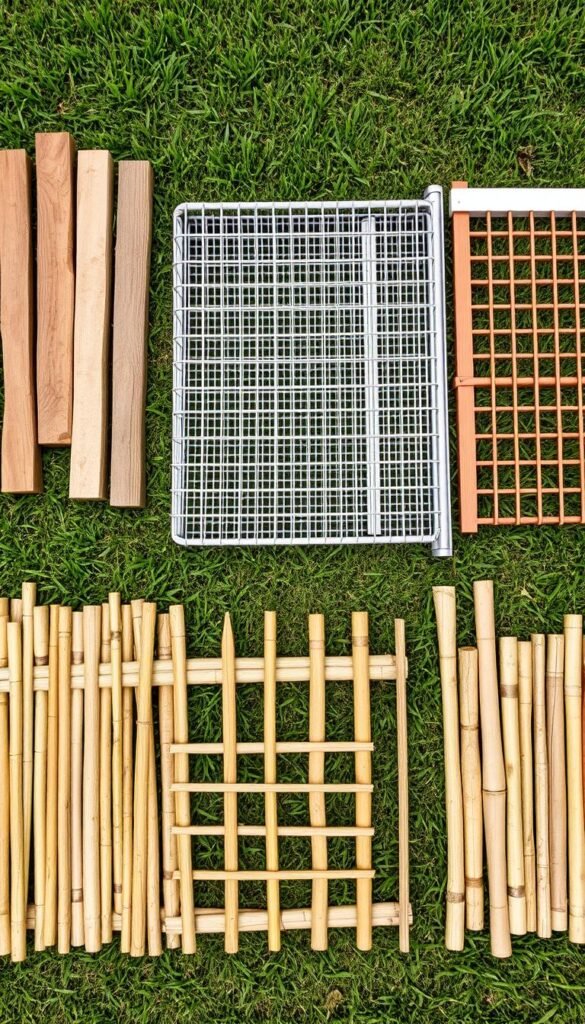
Building a protective barrier starts with smart material choices that match your budget and local challenges. The right combination balances durability with visual appeal, turning functional elements into design features.
Comparing Hog-Wire Panels and Hardware Cloth
Hog-wire panels framed in cedar offer dual-purpose strength. Their 4-inch grid pattern supports climbing plants while keeping rabbits at bay. For underground defense, ¼-inch galvanized hardware cloth stops burrowers when secured to fence bases with rust-resistant staples.
Consider these differences:
- Hog-wire lasts 15+ years but costs $35 per 16-foot panel
- Hardware cloth runs $1.20 per square foot but requires annual rust checks
- Both work best when paired with pressure-treated corner posts
Utilizing Recycled Materials and Cost-Effective Options
Untreated pine boards save 60% versus cedar, letting you replace individual planks as needed. One Wisconsin gardener built her entire structure using reclaimed barn wood and salvaged wire mesh, spending only $110.
When installing posts, dig 24-inch holes and pack gravel around 4×4 pressure-treated lumber. This prevents shifting during freeze-thaw cycles. For temporary beds, stake livestock panels directly into soil—they install in minutes and fold flat for winter storage.
Integrating Raised Beds and Supplemental Barriers
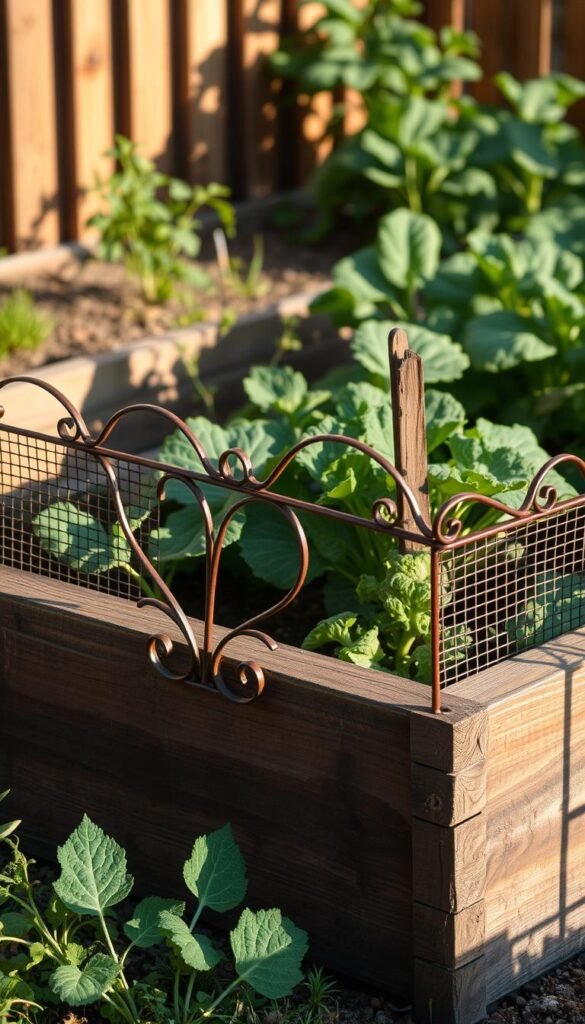
What if your raised beds could defend themselves against underground invaders? Strategic upgrades turn ordinary planting zones into fortress-like systems that stop pests while simplifying your gardening workflow.
Retrofitting Beds to Exclude Moles and Voles
Stop burrowing animals with a hidden underground shield. Dig a 3-foot-deep trench around existing beds, line it with ¼-inch hardware cloth, and staple the mesh to 12-inch baseboards. Backfill with gravel to prevent soil collapse. “This method stopped my carrot theft overnight,” reports a Minnesota gardener who protected 15 beds last season.
| Retrofit Method | Depth/Height | Materials | Cost per 10′ |
|---|---|---|---|
| Underground Barrier | 36 inches deep | Galvanized mesh | $18 |
| Hoop Frame System | 7/8-inch holes | Schedule-40 pipe | $14 |
| Surface Netting | 1-foot height | Floating row covers | $9 |
Enhancing Accessibility with Custom Hoops and Netting
Drill 7/8-inch holes along bed edges every 4 feet. Insert bent PVC pipes to create instant hoops for netting or frost cloth. At 12 inches tall, these beds warm soil quickly while keeping tools within reach. One Oregon grower notes, “I switch between pest covers and shade cloth in minutes—no more wrestling with stakes.”
Maintain 3-foot pathways between structures for easy access. Pair these solutions to create multiple levels of protection. Your plants get defense against both digging and flying pests, all while keeping your back happy during harvests.
Customizing Protection Based on Local Wildlife
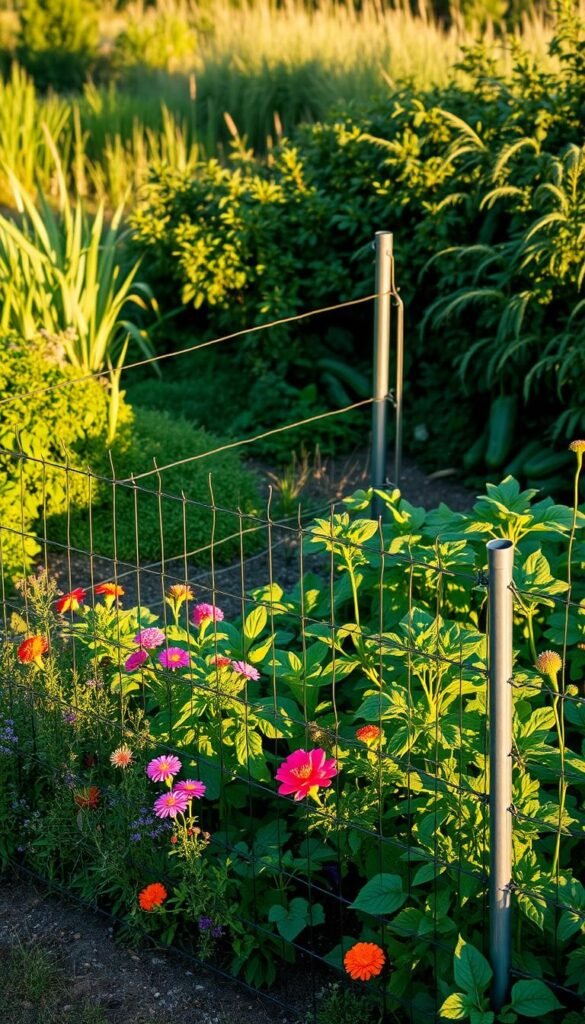
Tailoring your defenses to local wildlife ensures your harvest stays safe while blending with nature. Start by identifying which animals visit your space—footprints, nibbled leaves, or burrow holes reveal their habits. Each species requires unique solutions that address their behavior and physical abilities.
Adapting Methods for Deer, Rabbits, and Other Critters
Deer jump high but avoid tight spaces. Use dual 5-foot fences spaced five feet apart instead of single tall barriers. For rabbits, install wire mesh with ½-inch gaps at ground level, graduating to 2-inch openings higher up.
| Animal | Fence Type | Additional Measures | Cost Range |
|---|---|---|---|
| Deer | Dual 5′ barriers | Plant thorny shrubs | $300-$500 |
| Rabbits | Graduated mesh | Bury mesh 12″ deep | $80-$120 |
| Birds | Netting | Reflective tape | $15-$40 |
Utilizing Natural Repellents and Companion Planting
Grow deer-resistant plants like barberry near vulnerable crops. Their thorns deter creatures while adding color. Mint and lavender mask appealing scents, confusing animals entering garden areas.
Follow these steps for scent-based protection:
- Apply predator urine granules around garden borders monthly
- Rotate repellent types to prevent habituation
- Combine with motion-activated sprinklers
These layered approaches adapt as critters change habits seasonally. You’ll create defenses that work smarter, not harder.
Final Touches for a Vibrant, Protected Outdoor Sanctuary
Transform your growing area into a polished retreat with strategic final steps. Install heavy-duty strap hinges and self-closing latches on gates—these ensure smooth operation while maintaining tight security gaps. Proper shimming prevents sagging, letting wheelbarrows glide through without compromising defense against curious creatures.
Cap posts with decorative finials to protect wood from rain and add visual flair. Choose copper tops for rustic charm or solar-powered lights for evening ambiance. These details turn functional fences into design statements that elevate your entire space.
Schedule seasonal checks: inspect buried hardware cloth for rust and test gate latches after frost thaws. Watch for fresh digging near beds or chew marks on plants—early detection stops small issues from becoming disasters.
With these steps, your sanctuary remains both productive and picturesque. You’ll enjoy effortless access for harvesting while wildlife admires from a respectful distance. Now relax and savor your thriving oasis—the ultimate reward for smart gardening.
